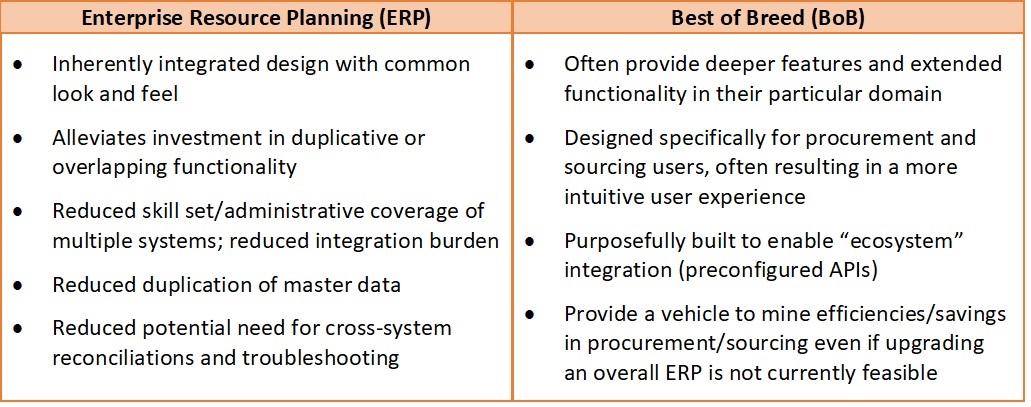As companies embark on digital transformation and continuous improvement initiatives, procurement is increasingly considered one of the pillars of that transformation. More than just a necessary back-office operation, procurement plays a critical part in a company’s overall financial strategy, and improvements in that area can cascade across the procure-to-pay (P2P) cycle all the way to the bottom line. In addition, efficiency gains in procurement can affect related processes in contracting, sourcing, spend analytics, vendor management and operations planning, and can help address supplier risk and supply chain resiliency. An efficient procurement function that is well integrated with the rest of the organization can make the difference between it being an average player versus a high-performing organization that is maximizing its profitability potential.
Digitizing procurement processes can bring coveted improvements in both performance and efficiencies. To attain these benefits, however, businesses must first identify what needs they are looking to address and how to choose a system that addresses them.
Procurement’s Common Challenges
Many procurement operations face both business and technical challenges. Partnering with the right suppliers while managing cost and quality are chief among them, but more tactically, procurement leaders need to address a lack of standard procedures, poorly defined data fields, use of multiple systems, integration challenges, manual business processes due to lack of system functionality and compliance and segregation-of-duty issues. Furthermore, in a world of constant change, mergers and acquisitions contribute to the complexities of building a holistic and efficient procurement organization as they increase the number of systems and processes and can exacerbate integration issues and business process execution. Finally, the difficulties companies typically have in successfully engaging with internal stakeholders and understanding and documenting how well their suppliers perform or have performed in the past adds to the problems procurement professionals must overcome on a daily basis and leads to poorly managed spend.
In an ideal world, manual workarounds are reduced to a minimum and there is a single source of truth for data. When a new supplier is considered, it should be easy to identify if a current or past relationship with that supplier exists, and if so, whether an active contract is in place, plus any other information, such as past pricing and performance. It should be easy to review competitive bid information for the same service, and all correspondence with that supplier during the negotiation process should be contained in a centralized system. Not only would a transparent and centralized process make the lives of procurement officers easier, but it would also contribute to the overall efficiency of the organization and reduce unnecessary expense.
There are many applications on the market designed to address these common pain points. But sifting through their features and exploring their compatibility with existing systems can be a daunting task. Below, we provide an overview of two categories of systems – best of breed (BoB) applications (such as Ariba, Zycus, Coupa, Basware and others) and enterprise resource planning (ERP) systems (such as SAP, Oracle, Microsoft and Workday). Both categories have value, with several factors to consider as companies make a decision about how each system meets their current and future needs.
System Comparison
The key difference between BoB and ERP systems is scope. ERP solutions are comprehensive software suites that manage and integrate numerous business activities such as procurement, inventory management, manufacturing, accounting and reporting, to name just a few. BoB solutions, on the other hand, target specific functions within an organization – such as procurement.
With respect to procurement, both ERP and BoB applications seek to better manage spend and enhance business process and compliance activities through process automation. And as more and more BoB solutions emerge and take up market share, some ERP companies are beginning to acquire them – such as the acquisitions of Ariba and Scout RFP by SAP and Workday, respectively – blurring the functionality distinction. While this may continue as a trend, the following features continue to generally distinguish the two categories of systems:
System Benefits Comparison
Considerations in Designing a “Best Fit” System
While the needs of each organization are different, few companies are probably starting from scratch in implementing a financial platform to improve back-office processes. In reality, what system to choose is almost always an “and” decision, not an “or” decision as BoB applications typically rely on a core ERP system of some sort to fulfill end-to-end business cycles.
Before moving forward with adding or changing systems, decision makers should seek to gain clear understanding and agreement on what they want to accomplish within the procurement function. Taking a business process-driven approach to the design and selection, along with technological design considerations, will produce a holistic strategic plan for identifying needed features and functionality of the solution and reduce risk.
The following are some of the key considerations in that process:
- Alignment to business strategy – What does the organization want to accomplish?
- Fit-gap analysis – How much customization will be needed to meet the organization’s business requirements?
- Degree of automation – Does the system eliminate/reduce manual processes? How much manual labor will be saved?
- User experience – Does the system provide the optimal user experience and ease of interaction to promote high adoption?
- Ease of configuration – Are the desired capabilities easily configured and achieved with an intuitive “wizard”-based configuration or does the system require code-based configuration?
- Implementation effort – Can the application be easily integrated or is it a major lift requiring a lot of time, resources and configuration/development?
- Maintenance and total cost of ownership – Is support for the new system readily available or will hires with new skills be needed to help run it?
- Data considerations – What will be the system of record for key data elements? How much historical data will be required to make the system functional? How easy is legacy data migration (master data and transactional data) into the new system?
- Training – Is the new system so different from existing systems that users will require extensive training? How intuitive and easy is it to learn?
- Security – Will the new system complicate the access management landscape, for example, by requiring multiple logins from users as they move from one module/system to another?
The best way to answer all of these questions is through a conceptual future-state solution design exercise, followed by a systems selection with tailored demonstration use cases to show how the design would address business needs. Solution design workshops can be conducted internally or facilitated by a third party with expertise in the latest P2P processes and technologies. This will help define the business and technical requirements needed to achieve the goals of the business.
Because procurement plays such a big role in the financial performance of an organization, giving proper attention to an application selection process is key to ensure the solution design addresses procurement’s challenges today and as the company grows in the future. It can help the organization make the best use of its resources and achieve the most return on its investment as it pursues its digital, finance and process transformation goals.
To learn more about Protiviti’s procurement and enterprise application solutions, contact us.






